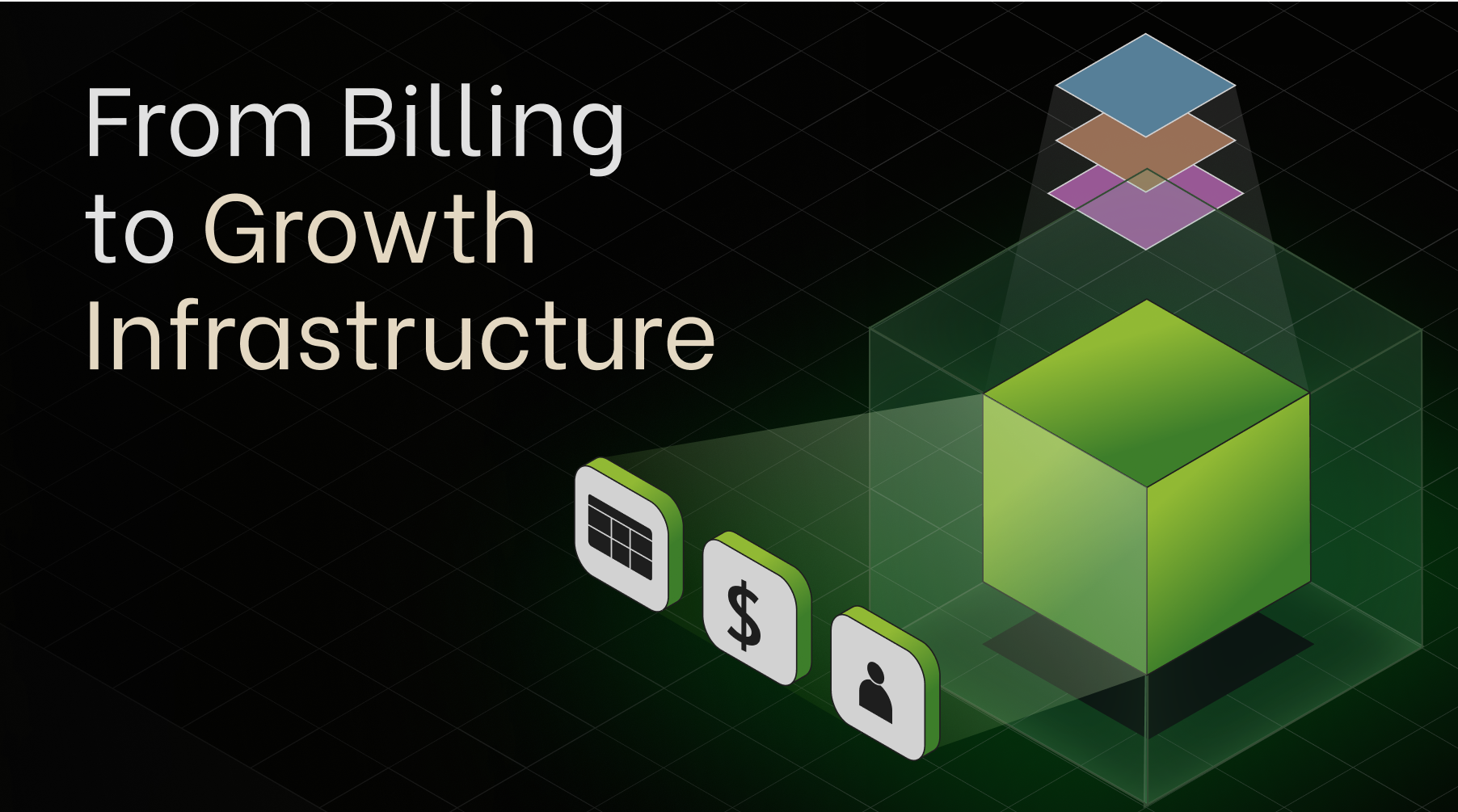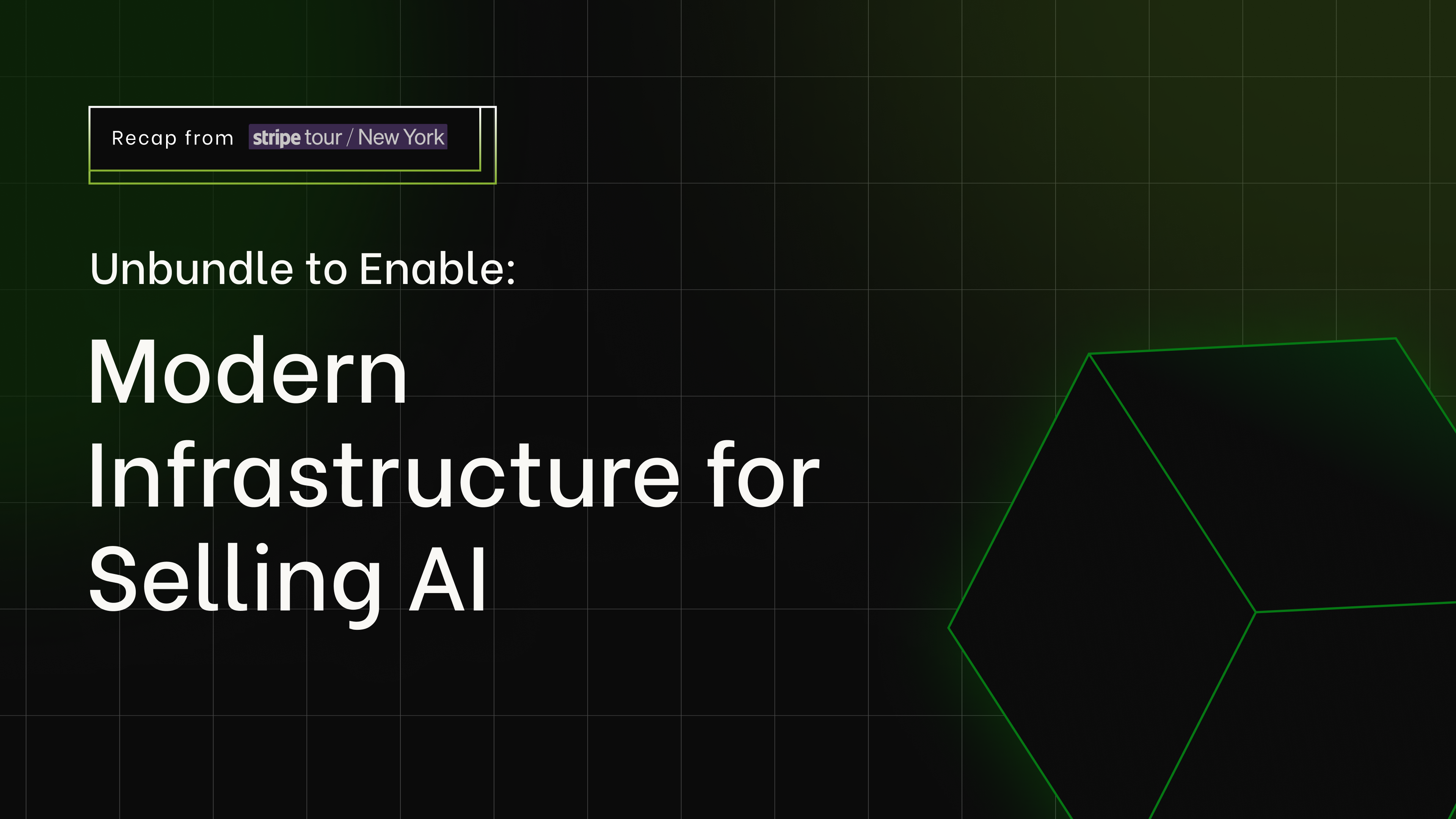Special thanks to Brandon Walsh (Director of Product Management, HubSpot) and Dennis Yu (Commerce Platform, Twilio) for their thoughtful feedback and insights. Your contributions pushed this piece, and the broader conversation around modern monetization infrastructure, to a higher level.
When the pressure to grow revenue is mounting, a new kind of infrastructure is emerging to support it: the MonetizationOS. It's how forward-looking teams are transforming Commerce Platforms from bottlenecks into growth accelerators.
In our recent post on the Rise of the Commerce Platform, we described a shift taking place in high-growth SaaS companies: the evolution from traditional billing systems to dynamic monetization infrastructure. We argued that forward-thinking Commerce Platform teams focus on speed, flexibility, and abstraction. They allow product teams to ship faster, sales teams to close more efficiently, and finance teams to operate with clarity.
And it sparked some powerful conversations.
We heard from monetization leaders at Twilio, HubSpot, Intercom, and Contentful, who not only validated the shift we described but pushed the narrative forward. They told us about pricing experiments dying in engineering backlogs. About GTM teams begging for packaging changes that would take months to implement. About the crushing reality that in an era where startups reach nine figures in revenue before their second birthday, every revenue idea was bottlenecked by a rigid monetization infrastructure.
They told us about pricing experiments dying in engineering backlogs. About GTM teams begging for packaging changes that would take months to implement.
They also pushed us to define the boundaries more clearly:
- Where does billing stop and monetization begin?
- Who owns this platform?
- And what should we call it?
This post is our response.
Why Nobody Wants to Build This Anymore
Let’s start with a familiar truth:
Nobody wants to build this infrastructure themselves anymore.
In the early days, stitching together Stripe, Salesforce, a few scripts, and a spreadsheet felt like a shortcut. It wasn’t elegant, but it worked, until it didn’t.
Fast-growing SaaS companies today are navigating an entirely new level of complexity, especially as AI becomes a core part of their product and strategy.
Fast-growing SaaS companies today are navigating an entirely new level of complexity, especially as AI becomes a core part of their product and strategy.
AI adds its own layers: pricing and packaging new AI features appropriately, dealing with higher and more variable usage patterns, charging based on value rather than just access, and even redefining what a “user” means as AI agents begin to operate autonomously within products.
On top of that, there’s the usual stack of challenges:
- Rapidly evolving pricing and packaging strategies
- Hybrid GTM models blending PLG and enterprise sales
- Legacy plan versions and backward compatibility
- Region-specific packaging, segmentation, and fulfillment
- Custom entitlements and provisioning logic
- GTM teams pushing for more control, faster
The problem isn’t just the complexity. It’s how many systems it touches.
The problem isn’t just the complexity. It’s how many systems it touches.
Supporting modern monetization at scale means managing SKUs, entitlements, metering, provisioning, in-product upgrades, trials, versioned packaging, offers, and integrations across billing, CRM, CPQ, data warehouses, and your core product. Each with its own model of what a product is, what a customer bought, what pricing should apply.
When every packaging change becomes a multi-system update, your ability to move slows to a crawl. Engineers become the bottleneck. And monetization experiments grind to a halt.
Think about authentication. Day one is usernames and passwords. But then comes OAuth, MFA, SSO, RBAC. Soon, you're spending more time building auth than your product. That’s why we have Okta, Auth0, Clerk, ... Monetization follows the same pattern, but with even more complexity.
Yes, some companies will still build pieces in-house. But stitching together a full stack is an expensive, slow, and increasingly indefensible choice.
It’s the same reason feature flagging moved from internal tools to platforms. Now it’s monetization’s turn.
It’s the same reason feature flagging moved from internal tools to platforms. Now it’s monetization’s turn.
The question isn’t "Can you build it?" It’s "Should you maintain it?"
Who Owns the MonetizationOS?
Let’s talk ownership.
Another great insight from the field:
This isn’t just about "billing." That’s often managed by Finance, and rightly so.
This is different.
Monetization is infrastructure. It should be owned by technical teams, the same way observability, CI/CD, or experimentation platforms are.
Monetization is infrastructure. It should be owned by technical teams, the same way observability, CI/CD, or experimentation platforms are.
We’re seeing this happen already. The teams leading this work include:
- Monetization Engineers
- Growth Platform Teams
- Infrastructure Engineers with a revenue lens
- Technical Product Managers focused on monetization
They own the system. They enable others.
Importantly, while the platform is built by engineers, its governance is shared. Product Managers, finance, and marketing help define requirements, business logic, and financial outcomes.
Monetization infrastructure provides safe, scalable interfaces for:
- Product Managers to update pricing and packaging
- Marketing to run contextual, dynamic offers
- Sales to customize bundles without engineering help
- Finance to model impact and enforce policy
It’s built by engineering. And it should be. Yet, its function sits between engineering and go-to-market, and thrives when governed collaboratively.
Naming the Category: Commerce, Monetization, or Growth?
One piece of feedback we’ve consistently heard, and fully agree with, is that the terminology in this space is still all over the place. Some teams refer to it as a Commerce Platform, others call it a Revenue Platform, Billing Infrastructure, Monetization Architecture, or Growth Infrastructure. We’ve also heard terms like Monetization Engine, Pricing Infrastructure, Packaging Stack, or even just the monetization layer.
At the end of the day, everyone’s pointing at the same set of problems: how you package, price, gate, meter, and monetize your product, and how you do that at speed, at scale, and in sync with the rest of your stack.
At Stigg, we call it the MonetizationOS. And we think that name matters, especially in SaaS.
Because while “commerce” can feel transactional, and “revenue” is a lagging indicator, monetization is a product function. It’s active. Dynamic. Programmable. And it happens in-app.
The MonetizationOS is:
- A deeply technical platform owned by engineering
- Built to manage in-product monetization experiences
- Integrated with your billing provider, CRM, CPQ, and data warehouse
- A single source of truth for pricing, packaging, entitlements, and subscriptions
- Abstracted in a way that empowers product, growth, sales, and marketing to operate independently, safely
Other teams may call it differently. We all agree it’s a layer that didn’t exist a few years ago. What matters is this:
The MonetizationOS is the infrastructure layer that makes monetization programmable, and scalable, across the entire customer journey.
The MonetizationOS is the infrastructure layer that makes monetization programmable, and scalable, across the entire customer journey.
Billing vs. Monetization: A Clear Line
Another critical distinction that came through in the feedback: we need to sharpen the contrast between legacy billing platforms and what we mean by a Monetization Infrastructure.
They may be connected, but they are fundamentally different domains.
Traditional billing platforms are essential, but they’re optimized for invoicing, payments, tax, and compliance. That’s the last mile of monetization.
Monetization happens upstream:
- In the product experience
- Through packaging logic, entitlement rules, and metering
- In how customers trial, upgrade, convert, and expand
Especially in usage-based models, monetization and billing are deeply intertwined.
When a customer questions their bill, it’s often because the link between usage and pricing isn’t clear. That’s not just a billing issue, it’s a product experience challenge.
Billing processes revenue. Monetization creates it.
Billing processes revenue. Monetization creates it.
And while billing ensures the transaction clears, monetization determines what to charge, why, and how to present it. And it’s what enables your teams to:
- Sync GTM motion with product motion, seamlessly
- Let sales configure bundles without breaking entitlements
- Give marketing the tools to trigger contextual offers
- Run pricing experiments without shipping code
It’s not just about charging. It’s about driving conversion, expansion, and retention.
It’s not just about charging. It’s about driving conversion, expansion, and retention.
More Than Monetization. It’s a Growth Engine.
We’re in the middle of a shift.
As Brandon from HubSpot pointed out, this isn’t just about supporting product catalogs. It’s about adapting to buyer preferences and GTM complexity.
The companies moving fastest aren’t just innovating on product. They’re innovating on how they price, package, and deliver that product.
The companies moving fastest aren’t just innovating on product. They’re innovating on how they price, package, and deliver that product.
AI is accelerating pricing complexity.
Customer expectations are rising.
And the GTM stack is more fluid than ever.
We’re seeing more teams move from:
- Static to dynamic pricing
- One-size-fits-all packaging to personalized entitlements
- Long rollouts to constant iteration
- Engineering-owned code to product-configurable logic
The MonetizationOS makes that possible.
It’s the connective tissue between your product and your go-to-market. It helps you experiment faster, convert better, and scale without slowing down.
The Way Forward: Beyond Monetization
The rise of the MonetizationOS signals something bigger.
It’s the professionalization of a function that has long been underfunded, fragmented, and misunderstood.
Just like DevOps, RevOps, or Growth Engineering became strategic functions by owning tooling, infrastructure, and experimentation, monetization infra teams are becoming essential to how software companies grow.
And they won’t be building it all themselves.
At Stigg, we’re working with teams at every stage of this journey to provide the primitives - versioned pricing, metering, entitlements, offers, and upgrade paths - that enable fast-moving teams to scale without friction.
MonetizationOS is here. Now it’s about shaping the standards, defining the patterns, and building the future, together.
Try Stigg for free, or book a 1:1 session to explore what the MonetizationOS could unlock for your team.




